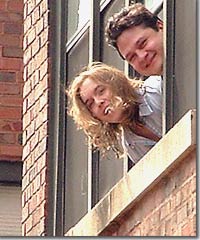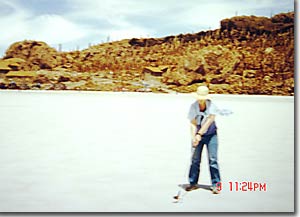Anne Catlla
As an applied mathematician, Anne Catlla, a postdoctoral associate at Duke University, applies mathematical methods to a wide range of physical phenomena, learning about a variety of interesting subjects in the process.

Anne and her husband, Sergio, leaning out the window of their home in Chicago.
Recently, she studied pattern formation in fluids. In particular, she studied Faraday waves, which appear on the surface when you take a container of fluid and shake it vertically. For example, you might see them on the surface of a cup of coffee in a car when sitting at a stoplight with the engine idling. You can also see these waves by filling a sink with water and running the garbage disposal, says Catlla.
When you shake a fluid in a controlled manner, you can get the ripples to form interesting patterns, such as stripes or square patterns, explains Catlla. “You can get some pretty elaborate patterns.”
Her research involved studying the connection between the precise way in which you shake the container and the pattern that forms. Figuring out this relationship requires some fairly complicated mathematical analysis.
Now, she is applying some similar mathematical tools to look at patterns in a completely different field: neuroscience.
In the brain, neurons are connected to each other in complicated networks. When one neuron fires, it generates an electrochemical signal that it passes onto another neuron, which passes it on to another and another. The brain also contains another type of cell, called the glial cell. Until recently, these cells were thought to be merely support systems for the neurons, but recent research indicates that they too may play a role in the transmission of information. Catlla and her colleagues are trying to figure out just what the glial cells do.
The glial cells are known to be connected to neurons, and they can pass chemical signals. Unlike neurons, which transmit signals in really fast spikes, glial cells transmit a slower wave of chemical signal. Catlla and her colleagues are looking in particular at a signal passed through calcium. One researcher in the physics department does experiments measuring how the calcium concentration changes through cells as a signal passes through, and tries to analyze what the network is doing. This produces a lot of data, which Catlla is figuring out how to analyze. In addition to this data analysis, Catlla develops computer simulations that model the neural network. “We’re working together to look for the signature of the effect of the glial cells.”

Anne playing golf on the Salar de Uyuni (huge salt flats) in Bolivia.
Though she hasn’t figured out the key of the glial cells yet, it’s exciting work, she says. “It’s been fun. I’ve learned a whole lot about neuroscience. I didn’t know much about it before starting this project. It’s always fun to have some new ideas to think about.”
Catlla says she stumbled into applied math. Growing up in Lawrence, Kansas, she liked math and science, but thought she wanted to be a teacher, or maybe a nurse, like her mother. She entered the University of Kansas as an engineering major on the advice of a friend but soon realized it wasn’t for her. She transferred to the school of education, but decided that wasn’t for her either. Since she had taken a lot of math courses and enjoyed them, she signed up as a math major.
Her path took another twist near the end of her senior year, when a physics professor invited her to do research in his lab. She was interested, but was about to graduate. So she arranged to continue her studies in math as a graduate student at the University of Kansas, while also doing research in the physics lab.
Working both in physics and math, she felt that she really belonged somewhere in between, and so was drawn to applied math. “I think that mathematicians and physicists and applied mathematicians all will look at the same phenomena and ask different questions. The questions that a mathematician asks will be perhaps more abstract. The questions a physicist asks tend to be more interested in what was coming out of the system. I was interested in the math, but I was also interested in the system. That drew me to applied math, because I felt at the time like this was bridging the gap,” she says. Since then she has found that there are physicists who are interested in math, and vice versa, but at the time she thought applied math was the right place for people like her who are interested in both.
She applied to graduate school in applied math at Northwestern University, and received her PhD five years later. Last August, she began a postdoctoral appointment at Duke University.
“Graduate school was the first time I started to understand what it meant to be a scientist or a mathematician,” says Catlla. Unlike in undergraduate work, where assignments are completed relatively quickly, in graduate school, if you get stuck on a project, as you often do, you have to keep working on it until you figure it out. That can be both very frustrating and very rewarding, she says. “When you figure something out, it’s so exciting. You really start to feel ownership of the work you’re doing. No coursework could ever compare to that.”
Like many people in math and science, Catlla finds that other people often say to her, “Wow, you must be really smart!” Catlla’s reaction is: “Well, no, what’s most important is that you’re really dedicated. I tend to jokingly say, well no, I’m just really stubborn.”
Though women are still fairly rare in math and physics departments, the situation is improving, and Catlla says that she never felt any blatant discrimination, though did notice subtle things, such as an occasionally inappropriate comment.
"It’s so much more subtle. It has to do with feeling very singled out. There were math and physics courses I took where I was the only woman. You might have a question, and you’re sitting there, thinking to yourself, “is this a stupid question?” And then, if I ask the stupid question, I’m not just the person who asked the stupid question, I’m the woman who asked the stupid question. And so I think that that kind of pressure, I’ve definitely felt many times.”
When she’s not at work, Catlla relaxes by doing yoga. “I love yoga. The very first thing I want to do when I get off in the evening, I want to do yoga.”
She has also been an active volunteer. Before she moved to North Carolina, she volunteered at a woman’s shelter, helping women with practical matters and providing emotional support. “I loved it. At one point I even considered changing careers. I have so much admiration for people who work in places like that,” she says.
Catlla is also a “politics junkie,” who frequently reads political blogs and has toyed with the idea of being a poll worker. She’s written numerous letters to her congressmen. And through the American Physical Society, she had the opportunity to lobby for increased funding for science. “To me that’s not a hobby, that’s an obligation of every scientist,” she says. “Scientists have an obligation to make sure the community is aware of what science is and the contributions that it makes.”











